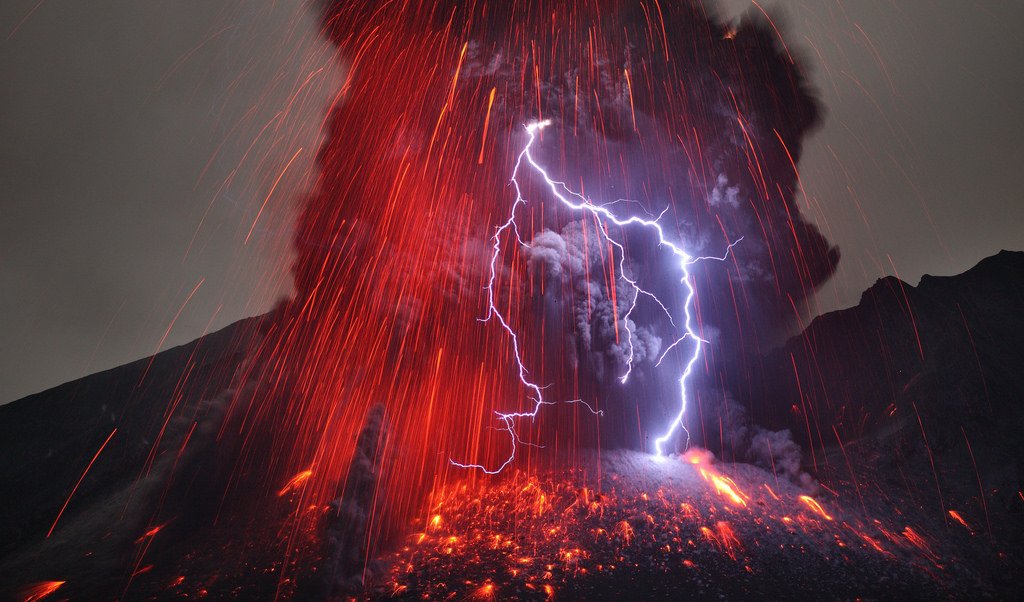If anyone has been following my Bizarre Natural Phenomena Series from its very first episode, you'd remember Volcanic Lightning (you can refresh your knowledge here: Bizarre Natural Phenomena Vol.1 - Volcanic Lightning AKA Dirty Thunderstorm).
 Image from: flickr.com - Author, Ajith Kumar - License, CC BY 2.0
Image from: flickr.com - Author, Ajith Kumar - License, CC BY 2.0
In case you have never heard of the term before, let me explain it in short:
Volcanic lightning is referred to discharges within volcanic ash plumes. Electrification of ash particles is believed to be caused by the plume's air dynamics. As the violent, overpressurized gases are spewed out of the erupting crater, particles get charged within the growing dark plume. Short discharges start occurring and lightning lasts longer and longer as more time from the original eruption passes. Flashes of lightning have no preferred path, but most of them appear downwards [3], especially as the plume keeps transitioning through its standard phases.
Particle segregation by turbulent flow in volcanic jets promoted by the gas overpressure at the vent is responsible for the early electrification of particles and for the chaotic distribution of charges in the growing plume, which promote short discharges with tortuous paths and no preferential direction of propagation. The maximum length of lightning flashes increases with time from the onset of the explosion. Organization of charges may be achieved at later stages when the plume transitions from the jet phase to the convective phase, which possibly promotes the generation of longer, more vertical cloud‐to‐ground flashes. [2]
 Crater / Plume image Mount St. Helens (Public Domain) - Image from: commons.wikimedia.org
Crater / Plume image Mount St. Helens (Public Domain) - Image from: commons.wikimedia.org
How did they hear it?
Up until now it was difficult to distinguish the sounds of an exploding volcano. A raging hole throwing up Hell's guts on Earth with defeaning roars did not allow human ears to discern the rumbles of the explosion from the thunder of the discharges. The circumstances were just perfect during two eruptions of Bogoslof volcano on the Aleutian Islands (Alaska); one eruption happened on 8th March and another one on 10th June, 2017 [4].
In this study researchers set up microphone arrays 60 km away from Bogolosof that picked up the sounds after the lightning strikes had occurred [1] (remember, light travels faster than sound, so the thunder would reach the microphones later). When studying the sound recordings side by side with the lightning strikes map, they managed to match the sounds with the lightning (taking into account the time delay of the sound signals compared with the flashes).
The team saw that the intensity of the sound matched that of the light and deduced that they may be able to predict the "behavior" of the plume. By studying the sounds of a dirty thunderstorm, scientists can "track" the position of the lightning within the plume. This allows them to predict the amount of ash that has been erupted and the sizes the plume can reach [4].
Why is it important?
Predicting the size of a volcanic plume is very significant for the safety of air travel. Flying through a volcanic plume is very dangerous, so being able to tell how the plume will "behave" is of critical importance.
Push the play button to hear it
The rumbling noise is the eruption and the pops and cracks are the sounds of thunder. It's not a song exactly, like I said in the title but still it is Nature's music!
References
[1] agupubs.onlinelibrary.wiley.com
[2] agupubs.onlinelibrary.wiley.com
[3] agupubs.onlinelibrary.wiley.com
[4] news.agu.org
[5] news.nationalgeographic.com
[6] popsci.com

Thank you so much for your time!
Until my next post,
Steem on and keep smiling, people!



